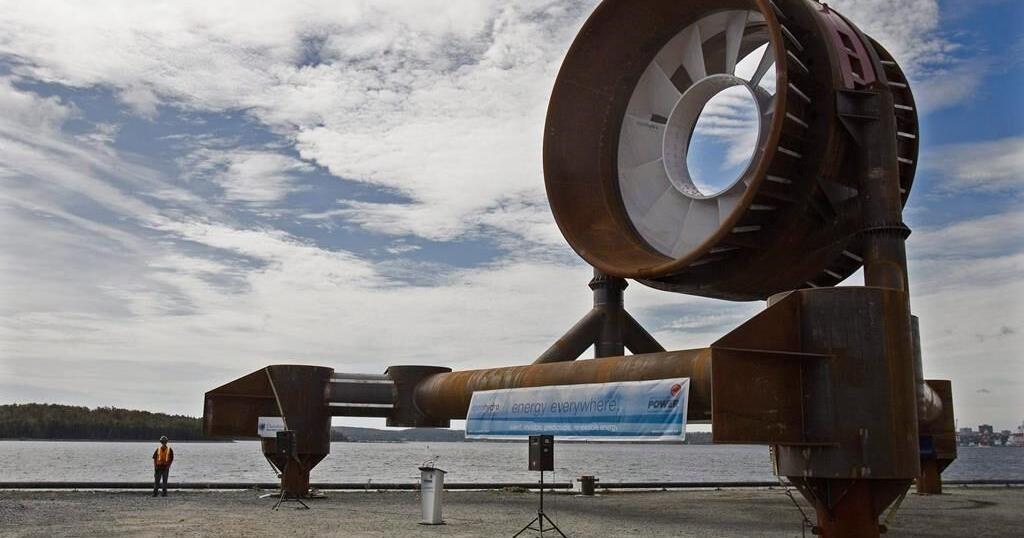HALIFAX – Another energy company has failed in its bid to develop tidal power from the Bay of Fundy, and fishing groups are worried about tonnes of materials and equipment left on the ocean floor.
The Nova Scotia government confirmed Thursday that Occurrent, formerly BigMoon Power, had filed for bankruptcy because it can’t pay its bills.
Last year, Sustainable Marine Energy — based in the United Kingdom — also failed, with estimated losses of more than $30 million. That collapse came after OpenHydro, which had partnered with Nova Scotia energy giant Emera Inc., left a 1,300-tonne tidal turbine stranded on the bottom of the bay in 2018 after going out of business.
Tory Rushton, the province’s natural resources minister, said Thursday that Occurrent’s demise was disappointing, but he said the series of costly flops hasn’t damaged the province’s enthusiasm for tidal energy projects.
“We’re willing partners here,” the minister said outside the legislature. “If we can harness it and make power at an affordable rate, then we’re certainly going to do that.”
Senior executives at Occurrent did not respond to emails seeking comment. A court document says Occurrent Power Canada Ltd. filed for bankruptcy last week. A creditors meeting is scheduled for Sept. 17.
A statement sent to creditors says the firm has $35.7 million in liabilities, and assets of almost $14 million, creating a deficiency of $21.7 million.
Lindsay Bennett, executive director of the Fundy Ocean Research Centre for Energy — a non-profit organization that operates a test facility and oversees berths for tidal energy projects — said in an email there are other companies hoping to harness the world’s highest tides.
“We know the case to pursue tidal is there; it’s a clean source of energy in our own backyard,” she wrote. “But not every company is going to succeed here. The bar is high.”
Bennett said there is one active berth holder at the test site. Eauclaire Tidal announced a partnership with Orbital Marine Power in December 2023.
Colin Sproul, president of the Bay of Fundy Inshore Fishermen’s Association, said he wants to know when the moorings that were to be used for the Occurrent project — four submerged rail cars filled with concrete — will be removed from the floor of the bay near the mouth of Walton harbour in the Minas Basin.
“There’s thousands of tonnes of garbage sitting on the bottom in one of the most ecologically sensitive marine environments in the entire world and the province has done nothing to remove it,” he said in an interview Thursday.
The province says it holds a $20,000 security deposit for the cleanup of what it refers to as “temporary gravel pads” on underwater Crown lands in the Walton channel. Rushton told reporters the province is going to “have to evaluate how we approach this.”
The Natural Resources Department said in an email that when Occurrent took over OpenHydro berth, the licence the company received included the posting of a $4.5-million bond to cover the cost of retrieving the equipment.
Sproul said the abandoned OpenHydro turbine has been stuck in Minas passage for six years, despite repeated calls by fishers for its removal.
Rushton said the massive turbine will be removed from the water.
“It’s my intention to get the turbine back up onto the surface,” he said. But he said it’s unclear whether that task will be the responsibility of a future operator at the berth, or if the province would hire a contractor to take on the job.
Sproul said trust has eroded between fishers and the tidal industry.
“Until they remove the junk that’s already there and meet us in a mutually agreeable way in honest engagement, there’s no future for tidal energy in the Bay of Fundy,” he said.
Darren Porter, a fisherman who allowed Occurrent Power to use land he owns to deploy its moorings, said he had enjoyed co-operating with the company, but now he said he shares Sproul’s worries about cleanups at the Walton site and the OpenHydro site.
“The biggest problem we have … with every one of these companies is they leave their stuff behind,” he said. “So now (the community of) Walton is sitting there with four rail cars (in the harbour channel) and they’re full of cement. … and they’re not easy to move.”
This report by The Canadian Press was first published Sept. 5, 2024.

























